I obtained a nice feedback from the “philosophical” article I posted regarding how to paint mounted units; where instead of discussing technical issues (or “how to paint…”), I paid more attention on the question mark “why”: why we do what we do. In my opinion, painting miniatures for wargames is not only about the painting, but it is also about telling a story. And these stories might be based on the (military) history; something that is real. And therefore, we can try to reflect this reality in our tiny armies. And in this post I would like to discuss some thoughts on the historical color of the uniforms, a topic that drives many people crazy; especially when we use the “wrong” color (note, wrong is between quotation marks).
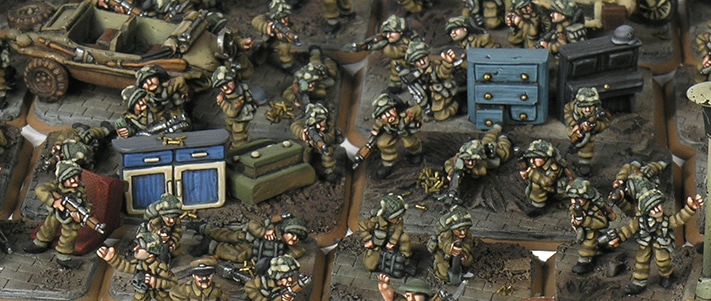
As a short introduction, in this article I would like to discuss three ideas mainly focused on uniforms of the XX century and during war operations (parades are something out of the scope here), although they can be applied to different historical periods. First, the color of a given uniform might vary enormously between batches and due to wear. Second, during the war time soldiers do not care about whether or not one jacket fits with a pair of trousers. They would have used whatever they could get, resulting in interesting combination of uniforms or colors that we might exploit. Third, soldiers are not clones! Especially before the “uniform” was introduced. I will discuss here something about ancient armies.
Color of the uniform: a single option?, or several options?
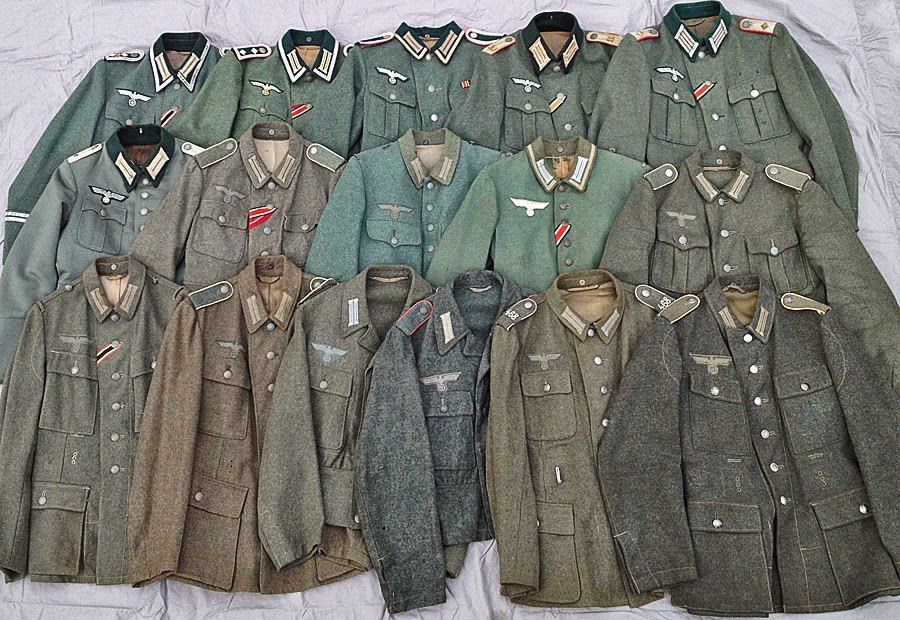
I would like to start the discussion of this section with a very nice photo that I usually show when someone mention that I am not using the right color when painting a uniform. Unfortunately, I do not know the original source, but I took it from another guy that used it with same purpose. This photo shows several jackets of the WWII German uniform. All of them correspond to the “fieldgrey” color, widely used by the Wehrmacht. But as you can see, the variation between colors is amazingly huge; even in the first line of jackets. We can easily speculate the origin of this variation. Different textile factories produced uniforms for the German soldiers, and although probably all of them have the same instruction regarding which fabric must be used, the dyes and so on; differences among factories and even among batches produced in the same factory would have been very difficult to avoid (specially tacking into account the lack of resources during the war), resulting in uniforms of different color. Additionally, the environment can easily modify the color and texture of the fabric. For example, the sun light is composed by rays of different wave lengths. Some of them are captured by our eyes (the visible spectra), but others not, such as the infra-red and the ultraviolet light. The last one, the UV light, is the more energetic and can modify the chemical structure of the dyes, resulting in the loss of the color. Finally, the exhaustive use of the cloths by soldiers during the war operations could easily wear out the uniforms, especially in those occasions when the soldier owns only a single uniform. And obviously, different people perceive the colors differently. Many references that we used to paint our miniatures are based on illustrations, where the artist reflects what he see. That is why is always better to use a photography of the original uniform if we have the chance. Or even better, visit a museum and take a look. In conclusion, there are several factors that can modify the color of the fabric; and therefore, we cannot talk about the exact color of a given uniform. For example, “fieldgrey” is a sort of greenish grey color, and you can use the paint jar that you like the most or the one that you have on your desk if you do not want to buy a new one. And nobody should tell you that you are using the wrong color. In conclusion, there are several factors to be taken into account that can modify the color of the fabric; and therefore, we cannot talk about the exact color of a given uniform. For example, “fieldgrey” is a sort of greenish grey color, and you can use the paint jar that you like the most or the one that you have on your desk if you do not want to buy a new one. And nobody should tell you that you are wrong.
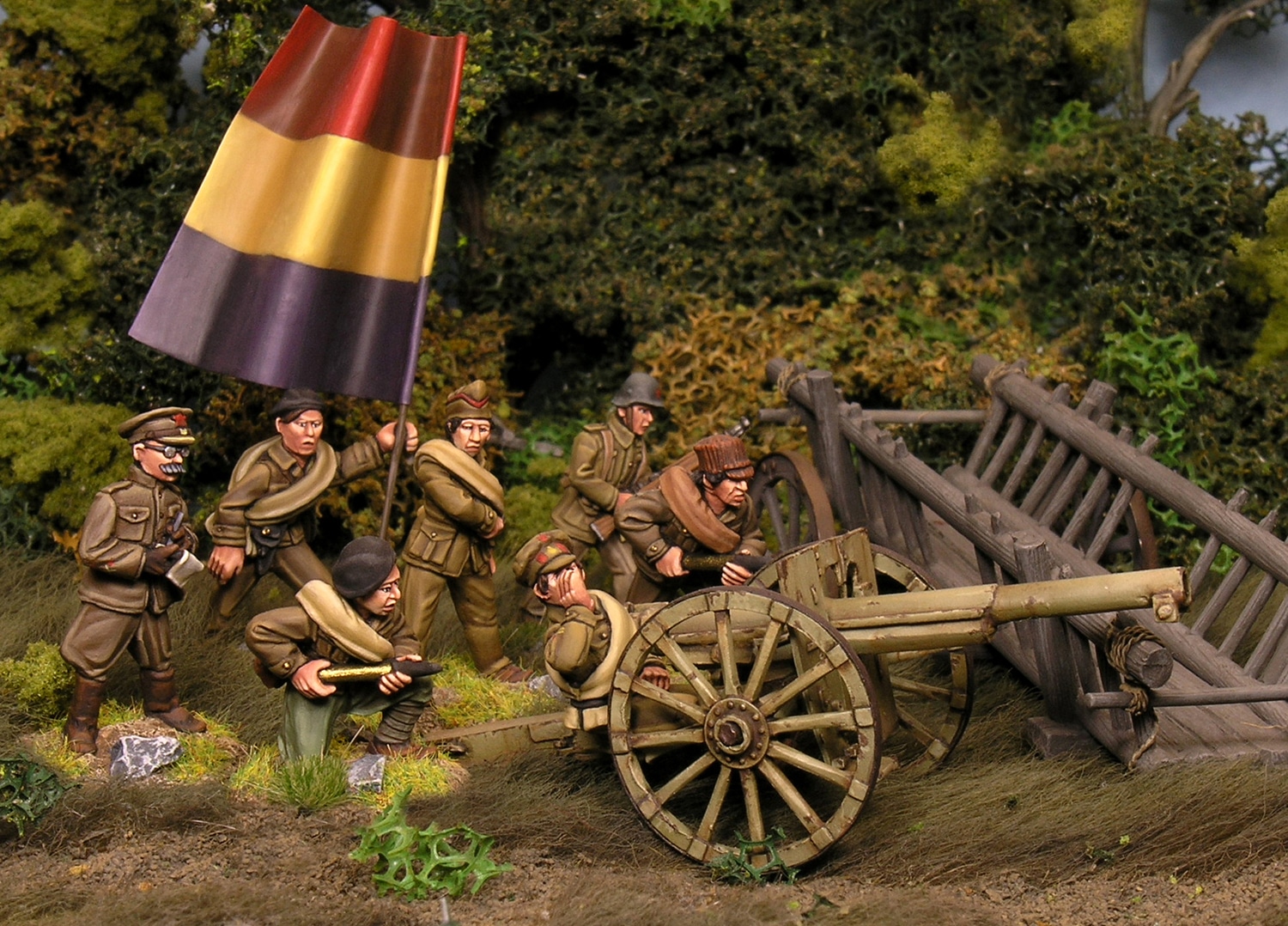
Additionally, can we exploit this idea when painting our tiny armies? Of course! If we want, we can use colors slightly different to paint the uniform of our miniatures. This would add some spices and charisma to our units; and therefore, I encourage you to do it. I will use as an example some Spanish Civil War guys (Empress Miniatures, 28mm) that I painted last year, four Republican gun crews. The Republican army uniform color was dark brown or “tostado” (toasted). Take a look at the pic: the two guys on the right wear a lighter-colored uniform, while the two guys on the left wear a darker one (the green trousers are captured from the enemy). The difference between both brown colors is not very striking, but we can easily perceive it. To do it I used the same color for the shades, Chocolate brown, but I used different colors for the highlights. I mixed chocolate brown with white for the dark uniform, whereas I used English uniform for the light one. Furthermore, in the second case I used pure English uniform to apply the last highlight; while in the dark uniform I stopped adding white when I reached the 1:1 proportion (chocolate brown : white). No pure white was used here at all! Therefore, in order to obtain different uniform colors we can do two things: (1) use different colors for the highlights and (2) vary the amount and/or intensity of the highlights.
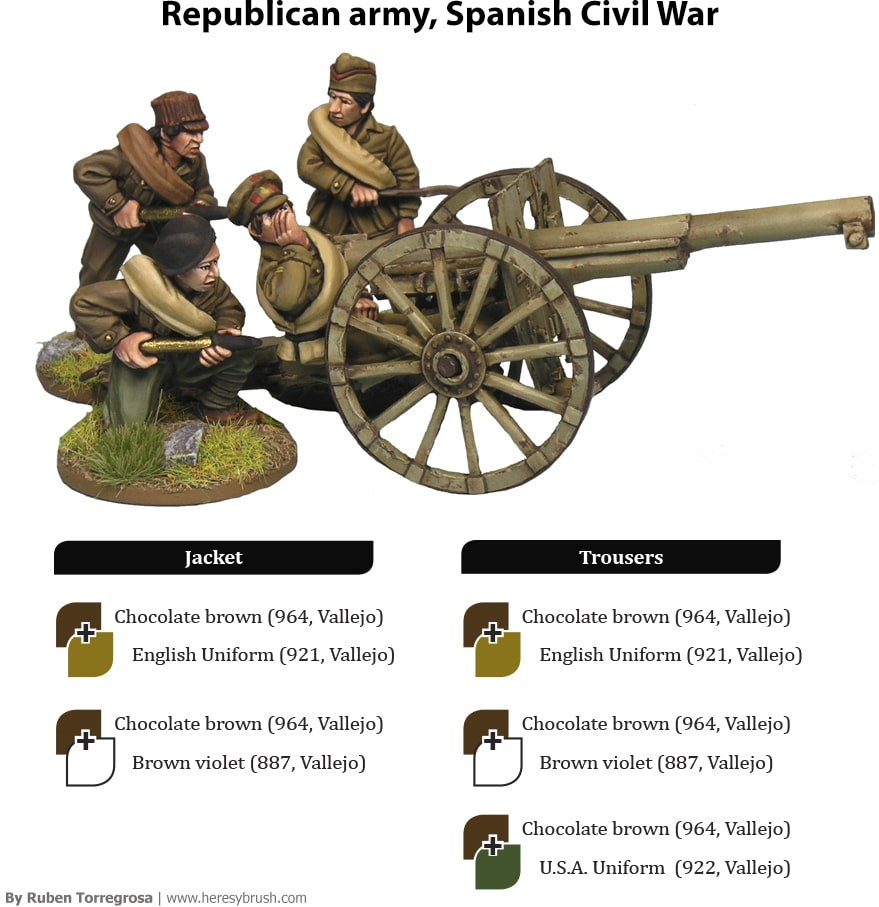
Different uniforms in the same unit
During war times the industry and logistics are under a huge pressure (and sometimes under bombs), which implies that the production goals might not be accomplished or the supplies do not reach their destiny. For example, the Deutche Afrika Korps were constantly asking for more supplies from Germany due the shortage of local resources and the constant British pressure. But Germany was focus on another war theaters and only could send a small portion of the promised supplies. Therefore, it was not uncommon to find German soldiers wearing part of Italian or even captured British uniforms. This circumstance resulted in German soldiers wearing a combination of jackets and trousers of different colors. We can do the same when painting a DAK army! Instead of painting all of the miniatures with exactly the same color, we can use different ones. This combination of colors is not only more striking, but it is also based on real facts. For example, when I painted some 15mm DAK Germans (from Forged in Battle), I exploited this situation. Basically I used only four colors: two ochre colors with English uniform (highlighted either with white or desert yellow), one dark brown color using Chocolate brown and a khaki or greenish color using Russian uniform. And I used these different colors to paint either the trousers or the jacket or I used the same one the entire uniform. Additionally, I tried to combine in the same base miniatures with different combination of colors. The result is quite interesting and eye catching, I think. You can find a step by step painting guide of these DAK soldiers in WSS 82.
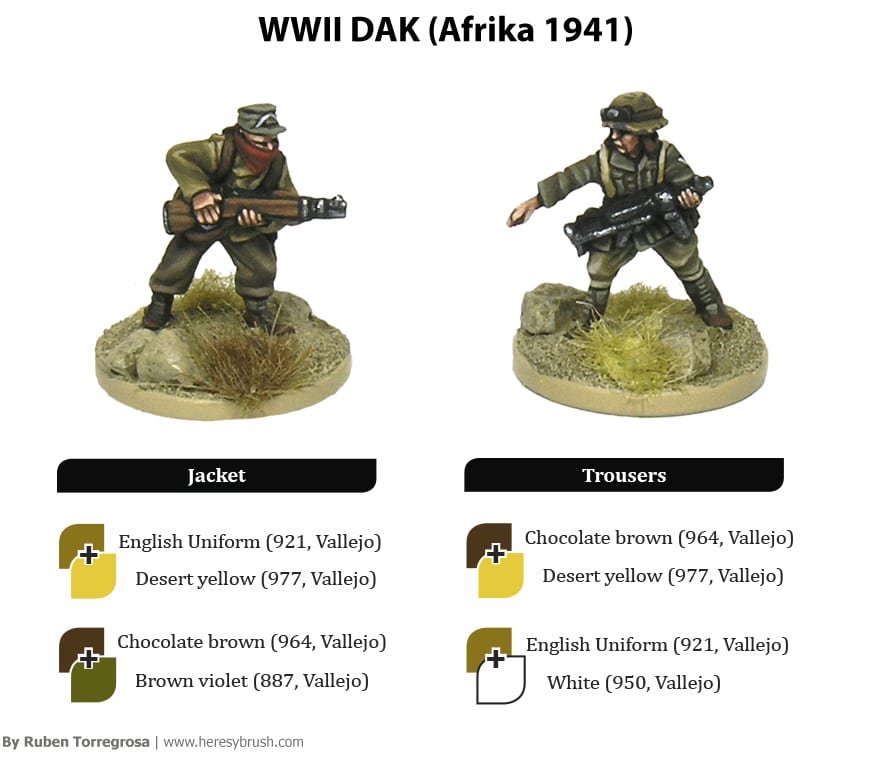
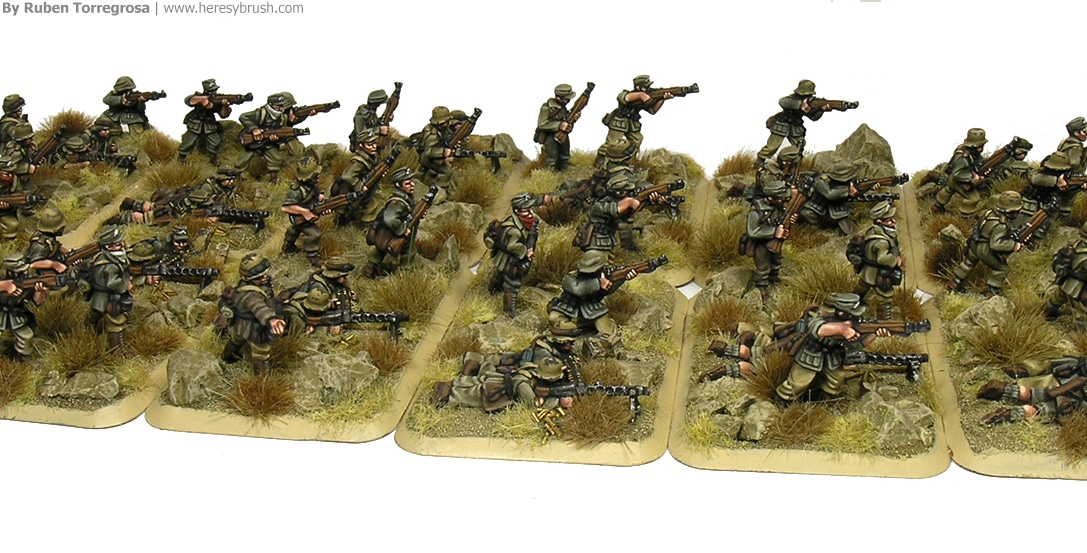 Another example can reflect those situations when a small batch of new uniforms arrived to a given unit. Only some soldiers would get the new clothes, while the rest would continue using the old ones. For instance, winter is coming and the closer logistic center sends to our unit whatever they have in the warehouse: remnants from the last year along the new stuff. And perhaps the old and new stuff might differ in their color for any random reason. This story was what I wanted to tell when I painted some German soldiers from Heer46 (28mm), dressed with winter clothes to cope with the cold in Kharkov, 1943. I used two different colors to paint the parkas, a dark green and a khaki color. Furthermore, I used three different options to paint the trousers: mimetic (splinter camo, only for the officer who could have used his influence to get them), white or the same dark green used for the parka. Additionally, I painted the helmets differently: some of them in dark grey while others had some traces of the washable white paint used as camouflage. When you put together all the miniatures, the unit is very striking, is not it? You can find a step by step painting guide of WWII German soldiers in Kharkov in WSS 87.
Another example can reflect those situations when a small batch of new uniforms arrived to a given unit. Only some soldiers would get the new clothes, while the rest would continue using the old ones. For instance, winter is coming and the closer logistic center sends to our unit whatever they have in the warehouse: remnants from the last year along the new stuff. And perhaps the old and new stuff might differ in their color for any random reason. This story was what I wanted to tell when I painted some German soldiers from Heer46 (28mm), dressed with winter clothes to cope with the cold in Kharkov, 1943. I used two different colors to paint the parkas, a dark green and a khaki color. Furthermore, I used three different options to paint the trousers: mimetic (splinter camo, only for the officer who could have used his influence to get them), white or the same dark green used for the parka. Additionally, I painted the helmets differently: some of them in dark grey while others had some traces of the washable white paint used as camouflage. When you put together all the miniatures, the unit is very striking, is not it? You can find a step by step painting guide of WWII German soldiers in Kharkov in WSS 87.
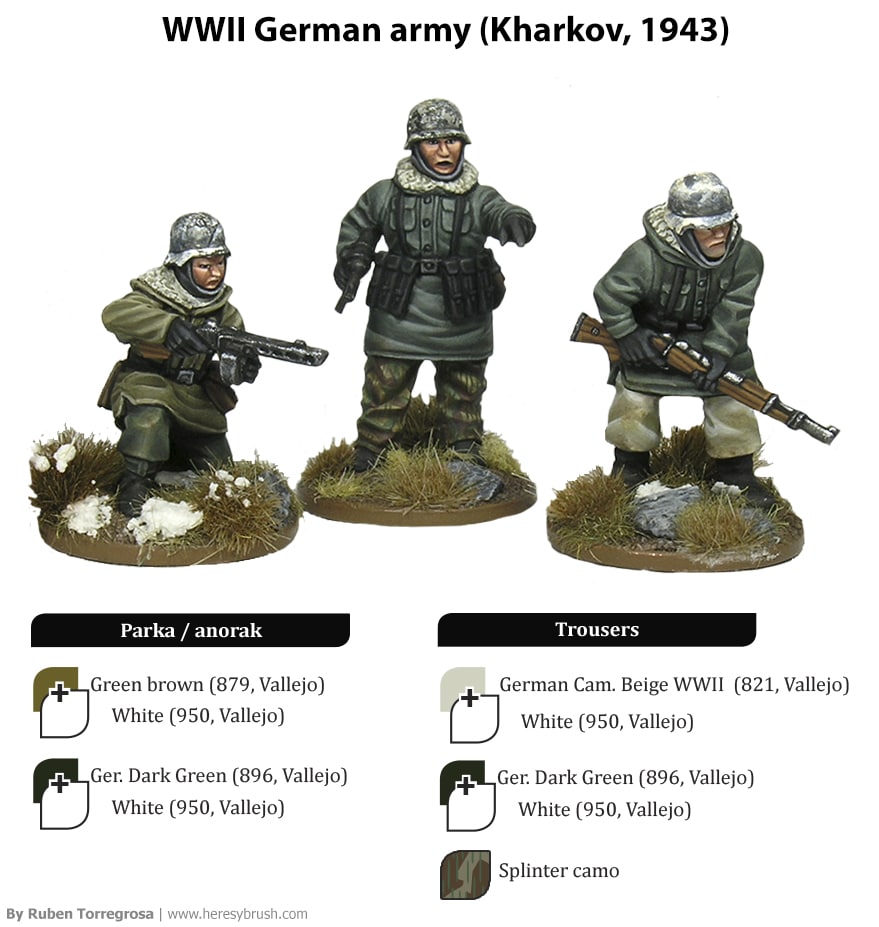
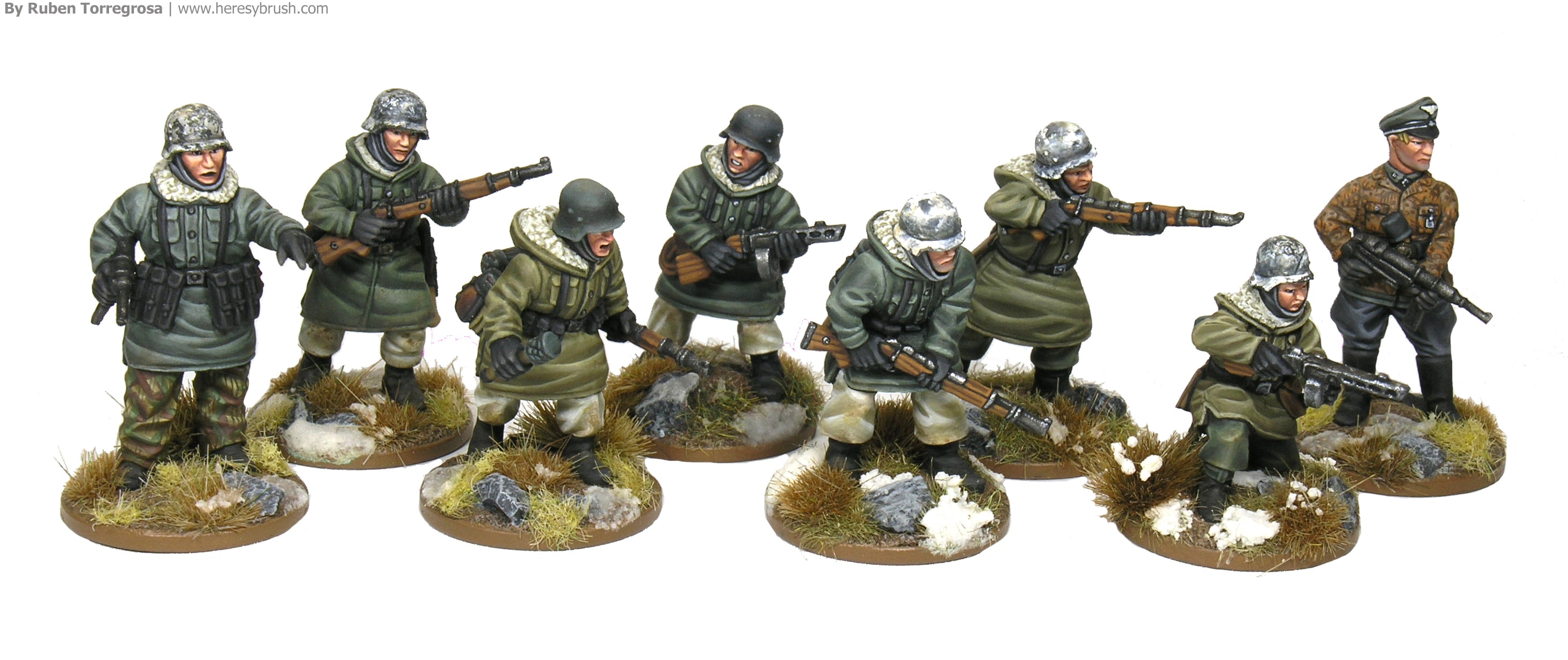 Moving a bit forward into the future (1980, Spain), another story that we can tell may reflect veteran soldiers wearing the old fashion uniform instead of the new one which is delivered to new recruits. And this is the case of my 1980 Spanish army (15mm, Totentanz Miniatures) were I combined two different colors: the “chickpea” uniform used by veterans who still keep it in their hands and the “NATO green” used by the newly incorporated soldiers. I used Beige brown for the first one and a mixture of USA uniform and Russian uniform in a 1 to 1 proportion for the second. And because I considered that many veterans would have accepted the new uniform as well, I painted only 1 out of 5 soldiers with the old one.
Moving a bit forward into the future (1980, Spain), another story that we can tell may reflect veteran soldiers wearing the old fashion uniform instead of the new one which is delivered to new recruits. And this is the case of my 1980 Spanish army (15mm, Totentanz Miniatures) were I combined two different colors: the “chickpea” uniform used by veterans who still keep it in their hands and the “NATO green” used by the newly incorporated soldiers. I used Beige brown for the first one and a mixture of USA uniform and Russian uniform in a 1 to 1 proportion for the second. And because I considered that many veterans would have accepted the new uniform as well, I painted only 1 out of 5 soldiers with the old one.
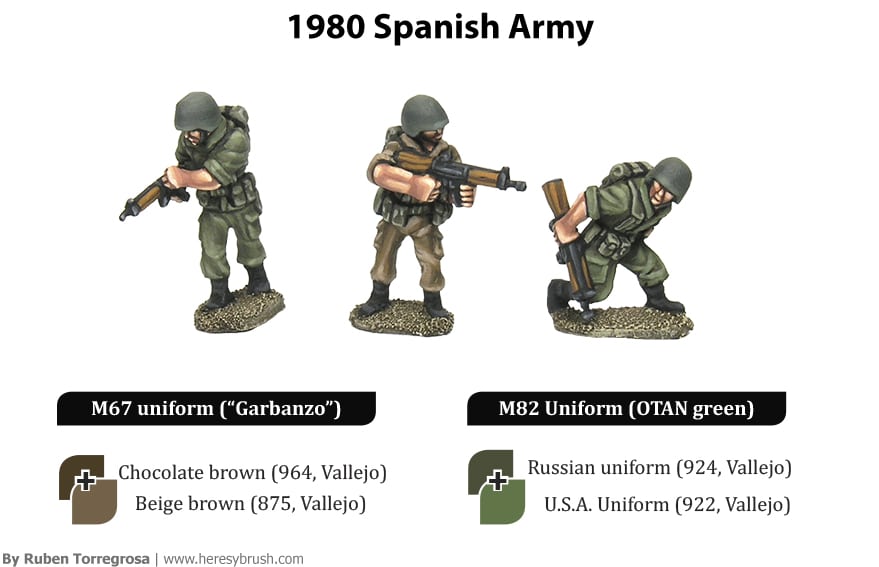
In conclusion, we can tell many stories by painting the uniform of our miniatures with different colors, which also increase the visual impact of the unit. Nevertheless, obviously we cannot do this in all the cases. It depends on the historical unit that we want to represent and the historical circumstances at that point. This means that need to do some research to understand how we should paint our miniatures. It is not only about the uniforms, but also about the situation of the war at that point. Imagine the German army during the last months of the WWII. Mimetic clothes are widespread and kampgruppen merging different units are frequently formed. Therefore, we can combine mimetic jacket or trousers in very different ways. I have not told this story yet, perhaps soon… And although we are talking here only about infantry, we can follow the same ideas when painting vehicles. Always based on historical facts, we can combine different camouflages in the same unit.
Ancient warriors
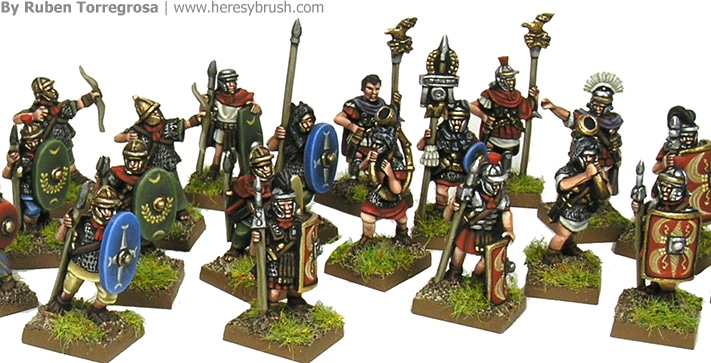
In the last section I would like to discuss something concerning the ancient armies. Until now we have seen that soldiers of the XX century armies used more or less the same uniform. However, two millenniums ago, the warriors –not soldiers, because with the exception of mercenaries they did not receive a salary or were not paid; and the words soldier and salary are probably derived from the Latin word solidus, a coin Roman gold coin- wore whatever they could. Romans might be placed in a different pot, because surprisingly their industry was highly developed at that time and the army was financed by the state. Nevertheless, a peasant from Africa or a citizen from a Greek polis would probably have used civilian clothes, on top of which they could put an armor if they could afford it. This means that we have “infinite” possibilities to choose the color of the tunic. Actually, they are not infinite because according to the historical facts we know that some dyes were very difficult to obtain and were very expensive, such as the “imperial purple” (derived from the mussels known as Murex), mainly used by the aristocracy, or the yellow or orange (derived from saffron), used mainly by rich people. An anecdotic example is the Immortal elite unit of the Persian army during the Medic wars, whose warriors commonly used yellow and purple clothes to demonstrate the wealthy of Persia. But common warriors could not afford it. One of the cheaper options, and available for the poor, was the red or pink dye derived from lichens and plants such as madder (Rubia), or just natural fabric whitened with chalk. Another option would have been to directly use the natural fabric, characterized by its dun or brownish color. This means that whether we are painting a unit of common warriors we still have plenty of different options: browns, yellowish/ochre, white, dun, grey, red, etc. However, probably because it is easier for us, we usually use one or two colors to paint the tunic in all the miniatures, resembling a “clone army” when the uniform was not even invented yet! Instead, we should use a wide range of colors (if the real facts allow us, of course) to increase the visual impact of our unit. Note, I am not saying that we should paint the tunic of every single miniature of the unit with a different color. But if we have a unit of twenty warriors, we can choose four or five colors and then combine them in different ways. Additionally, we can also vary the colors of the accessories.
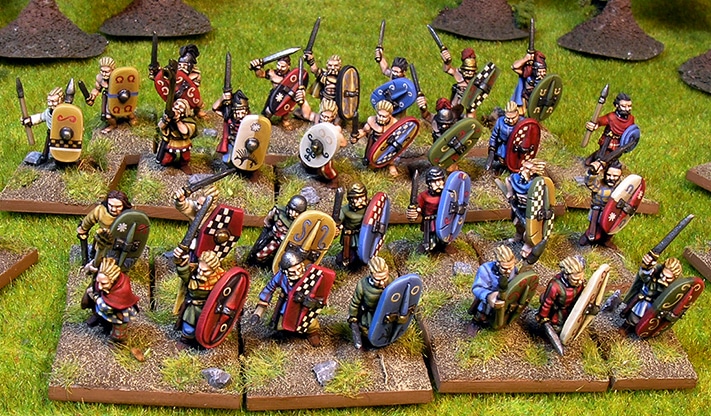
For instance, I have been recently painting some 28mm Iberian and Numidian warriors from Victrix Miniatures, and I have used a couple of browns, white and red to paint the tunics. Additionally, I added some decoration in the tunics with different colors to increase the variety. And in order to increase the individuality of the warriors, I used two different brown colors to paint the leather (Dark oxide plus Flat brown or Chocolate brown plus Beige brown); and iron or brass colors for the metal parts (for example, some of them wear an iron helmet while others have a bronze one). The proper uniform did not exist at that point, so we should reinforce the “randomness” or individuality of the warriors. And we can do it by using a wide color palette. You can find a step by step painting guide of Iberian warriors in WSS 86 and of Numidian warriors in WSS 88.
On the other hand, the 30YW miniatures (15mm, Totentanz) I have been lately painting may serve as another case to exemplify a huge diversity of colors. Here I have used many different colors to paint the clothes; not only several brown colors, white and black, but also red, blue, yellow, green and even purple. Once again, we can tell many stories when painting our miniatures. For example, we can consider the following story here: during the XVII century, Spanish soldiers were paid sometimes with precious fabrics from Flandes, as the State could not get the money to pay them. As a result, some soldiers really looked like kings! This historical fact beside the explosion of colors that was initiated during the renaissance can determine how we paint our miniatures. However… I wanted to tell a different story here. Inspired by the magnificent work of the Spanish painter Ferrer-Dalmau, I wanted to simulate a dark atmosphere, dominated by dark days spotted with the black smoke of the black powder explosions. In order to achieve this “dark environment” I used a dark brown color such as Chocolate brown to work the shades of the most part of the colors. By using the same shade color in almost all cases we can obtain a coherent looking in the whole unit that resembles the darkness I was looking for. You can find a painting guide of these guys here.
As you can see, I focus very much on the story, because I really like to think that we are story-tellers besides painters. Many of us are also history lovers, and by doing this we can build a sort of “bridge” between the past and today. This hobby is our personal time machine! As a final summary, remember that you can vary the color of the uniform to reflect the usage and environmental effects; and if you have the chance, you can even combine different uniforms or colors in the same unit to make it more striking. If you have any other point of view, please, feel free to share it with us in the comments!
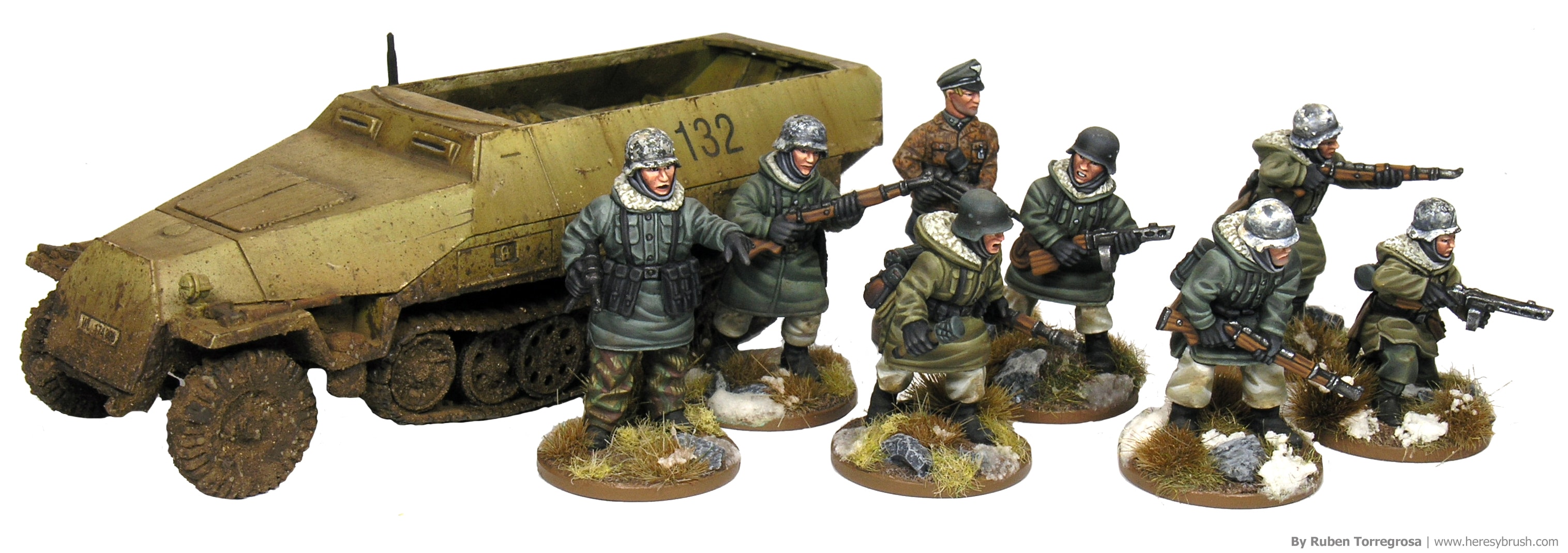
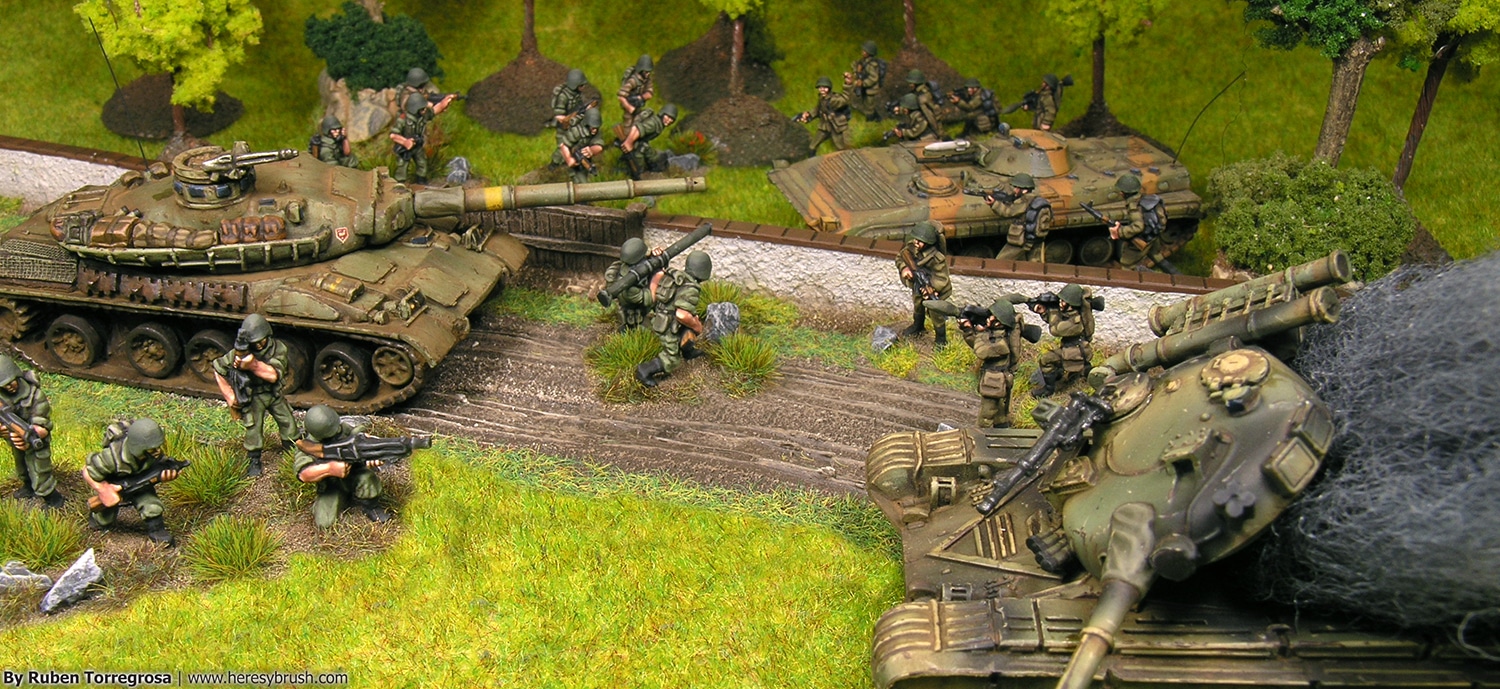

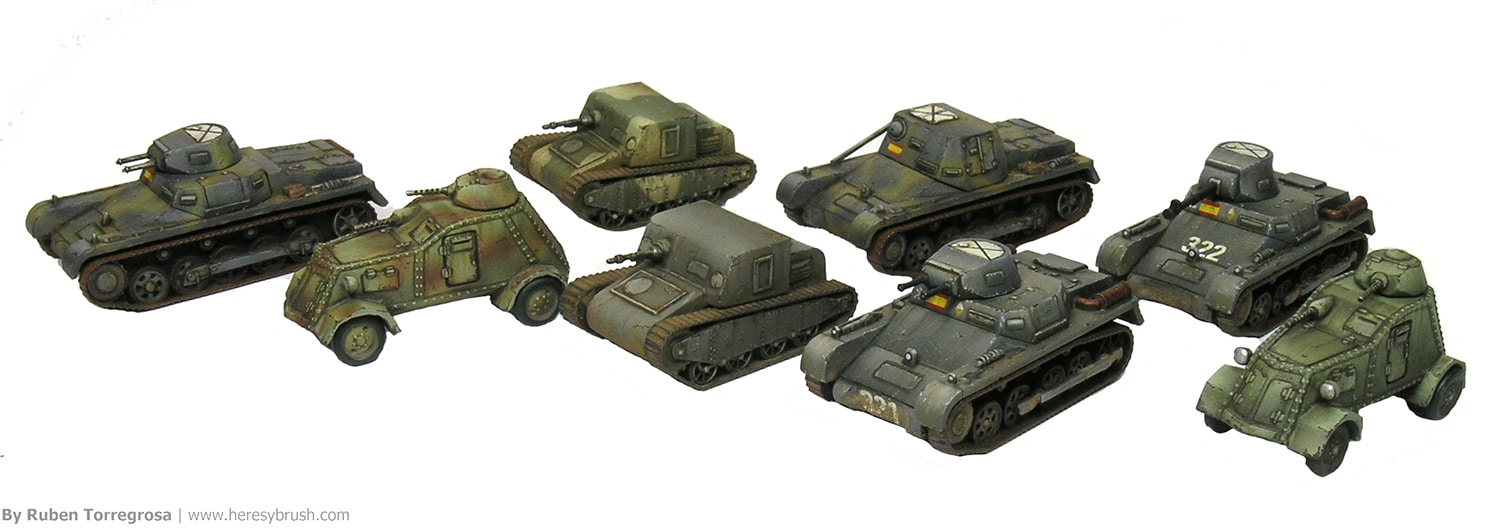
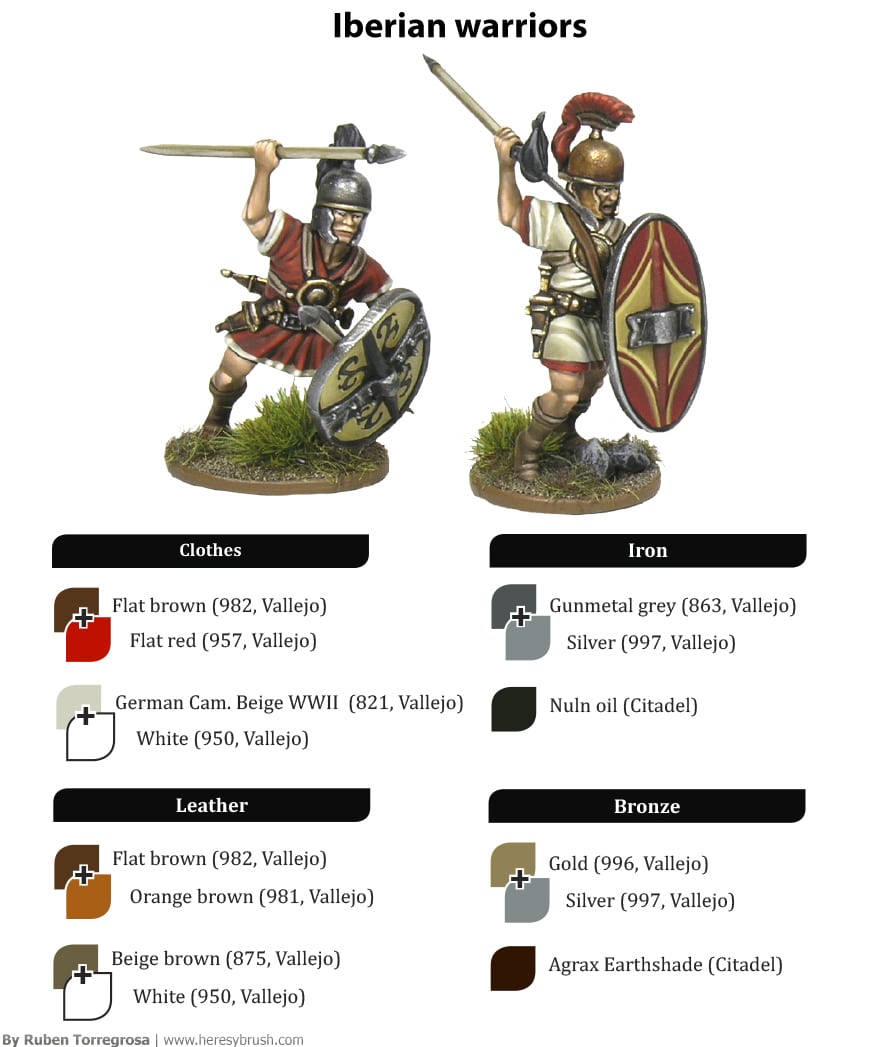

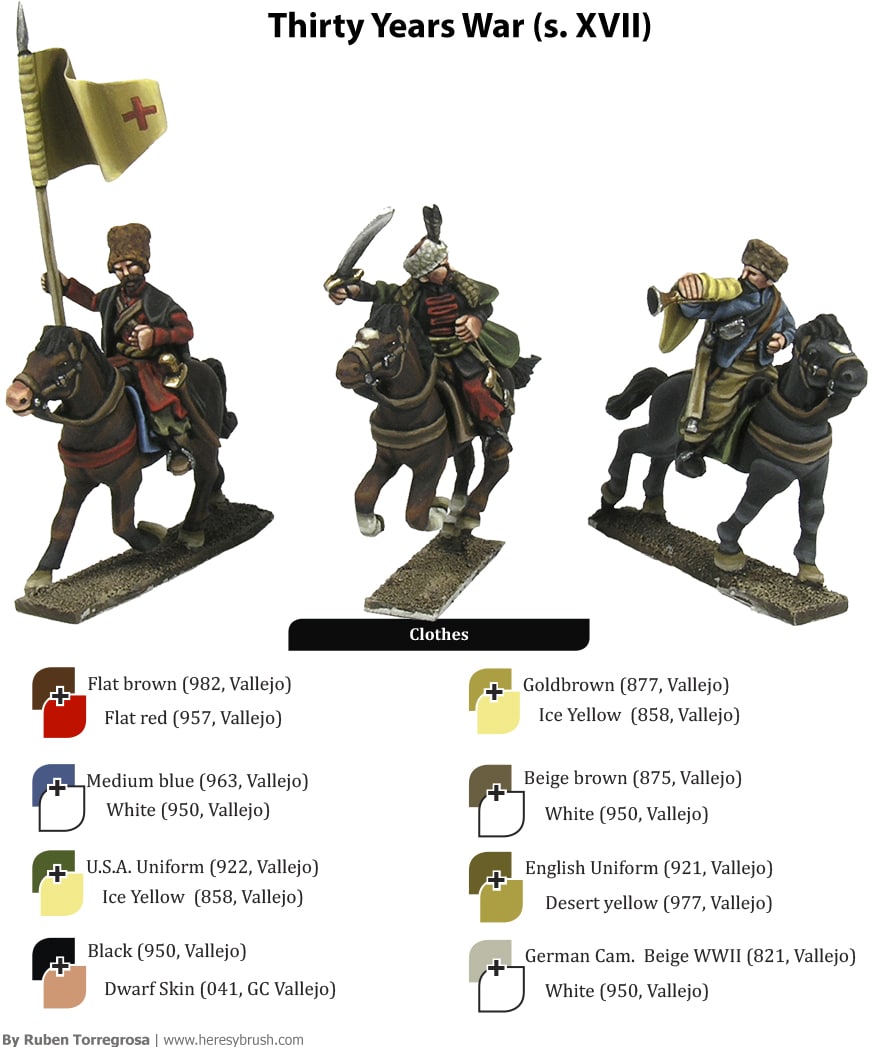
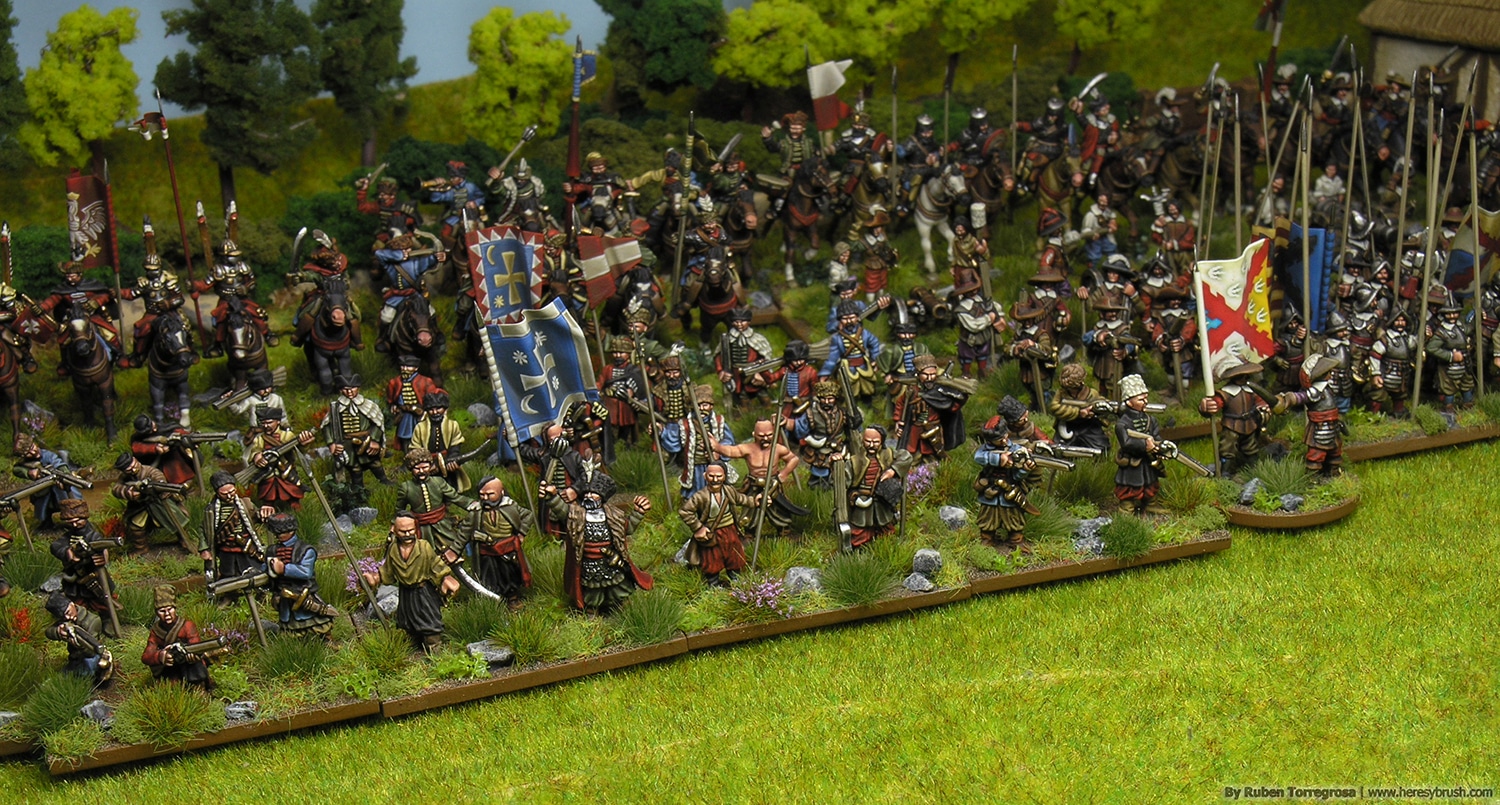
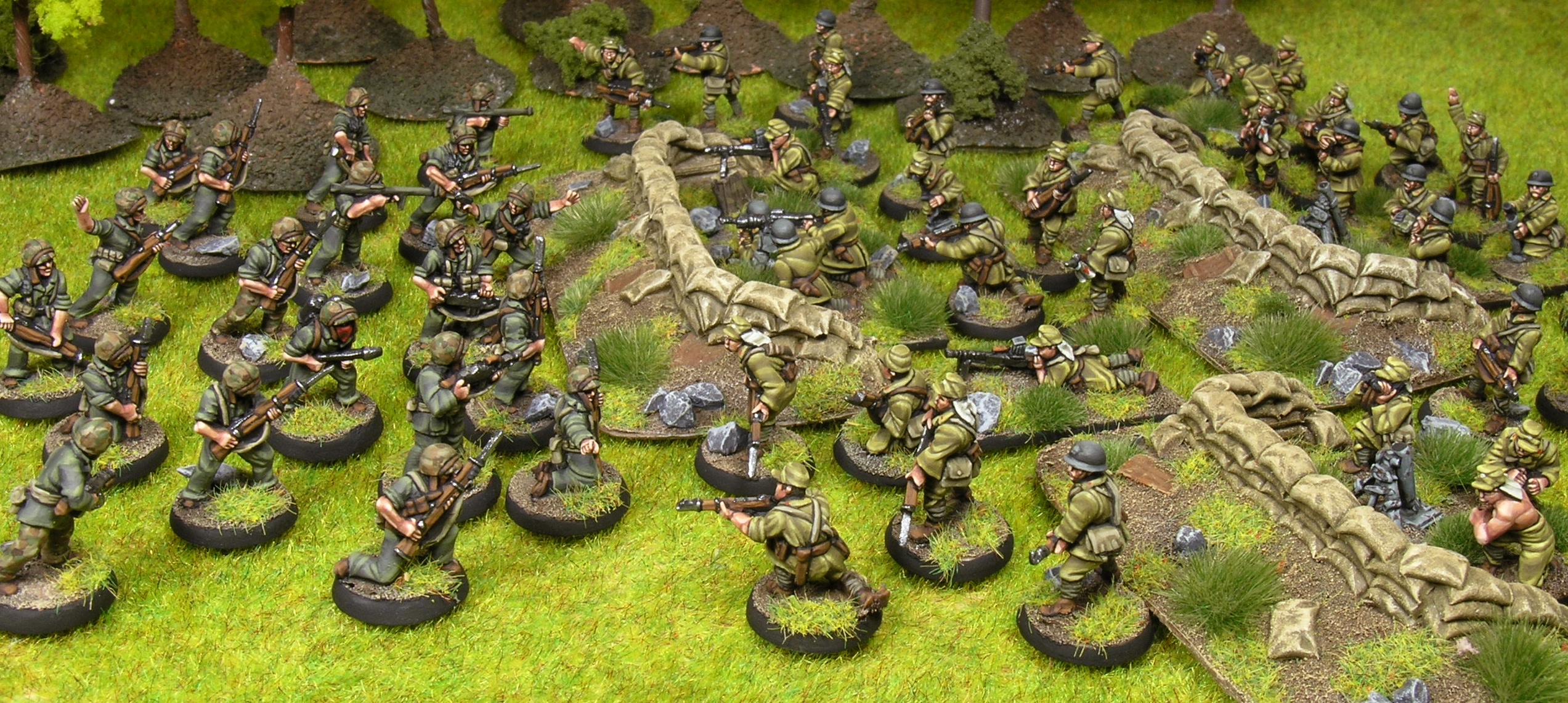
2 thoughts on “Painting uniforms”